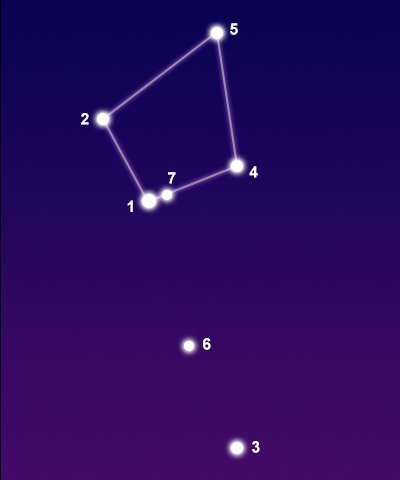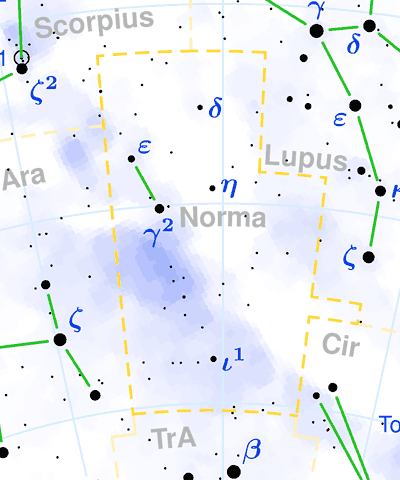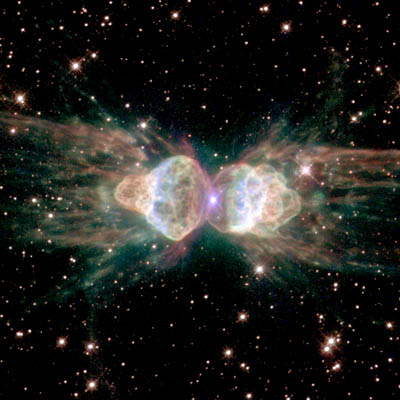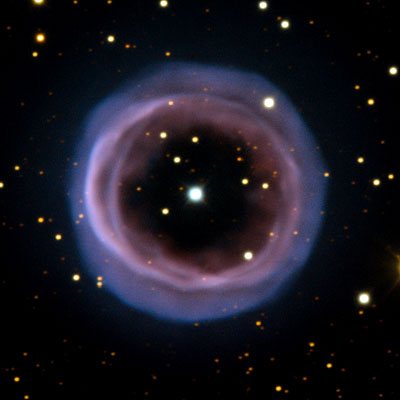Pronunciation:
(NOR-muh)Abbreviation:
NorGenitive:
NormaeRight Ascension:
16 hoursDeclination:
-50 degreesArea in Square Degrees:
165Crosses Meridian:
9 PM, July 5Visible Between Latitudes:
30 and -90 degreesThe constellation Norma, the carpenter's square, is located in the southern hemisphere of the sky. It is completely visible at latitudes south of 30 degrees from April through June. It is a small constellation, occupying only 165 square degrees of the sky. This ranks it 74th in size among the 88 constellations in the night sky. It is bordered by Scorpius to the north, Lupus to the northwest, Circinus to the west, Triangulum Australe to the south and Ara to the east.
There are no myths associated with the constellation Norma. It is one of the 14 southern constellations named by Abbé Nicolas Louis de Lacaille in the 18th century. It represents a carpenter's tool called a square, or a level. Lacaille originally called it l’Equerre et la Regle, which meant "the Square and the Rule". The name was later Latinized to Norma et Regula and eventually shortened to Norma. The constellation has also been reduced in size since its discovery. The stars that were originally Alpha and Beta now belong to the constellation Scorpius.

points of interest below © Sea and Sky

© Torsten Bronger CC BY-SA 3.0
Gamma-1 Normae
Epsilon Normae
Iota-1 Normae
Eta Normae
Delta Normae
N/A
N/A
N/A
N/A
N/A
Yellow-White Supergiant Star
Binary Star System
White Subgiant Star
Yellow Giant Star
White Dwarf Star
4.98
4.52
4.63
4.65
4.73
Norma is composed of faint stars. In fact, it contains no stars brighter than magnitude 4. The brightest star is Gamma-2 Normae with a visual magnitude of only 4.02. It is a yellow giant star located approximately 127 light years from Earth. Gamma-1 Normae is the second brightest star with a magnitude of 4.98. It is a yellow-white supergiant star over 1,436 light years from Earth. Gamma-1 and Gamma-2 form an optical double star. To the naked eye they appear as a single star but they can easily be separated with a pair of binoculars. The third brightest star in the constellation is Epsilon Normae with a magnitude of only 4.52. It is a binary star system that lies about 400 light years away.
Norma contains no Messier objects but does contain a few notable deep-sky objects. The Ant Nebula (MZ 3) is a planetary nebula located 8,000 light years from Earth. This planetary nebula is unusual in that it is bipolar, containing two distinct globular lobes. The Fire Ring Nebula, also known as Shapely 1, is another interesting planetary nebula with a distinctive ring of blue and purple gas. The Norma cluster is a rich cluster of galaxies. It is one of the most massive galaxy clusters known to exist. It is thought to be the Great Attractor, a massive object that is pulling the Virgo Supercluster, the Hydra-Centaurus Supercluster, and our own Local Group of galaxies towards it at over 600 kilometers per second. These objects are extremely faint and can only be seen in very large telescopes.

seen by the Hubble Space Telescope

© European Southern Observatory / CC BY 3.0



